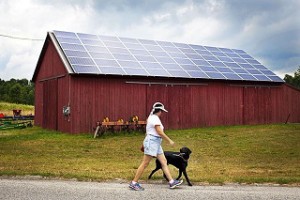 In the first half of 2017, Germany set a new record for renewable energy use. The country, which is a longtime clean energy leader, got 35 percent of its energy from renewable sources. On certain especially windy and sunny days, Germany has received as much as 85 percent of its power from renewables.
In the first half of 2017, Germany set a new record for renewable energy use. The country, which is a longtime clean energy leader, got 35 percent of its energy from renewable sources. On certain especially windy and sunny days, Germany has received as much as 85 percent of its power from renewables.
The share of renewable energy production in the European Union as a whole reached 16.4 percent in 2015, and the EU is aiming for a higher share. Here’s how they do it.
Renewables on the Rise
Of all the energy capacity the EU added to its electric grids in 2016, 86 percent was from renewable resources. Wind energy even surpassed coal as Europe’s second-biggest source of electricity, beaten out only by natural gas. Because the wind is intermittent, though, coal still met more energy demand.
Solid biofuels and renewable waste, burning trash and organic matter for fuel, was the most common renewable energy source in Europe in 2014, followed by hydropower, wind and solar. Wind and solar saw a significant increase in installation though, especially with the rise of offshore wind farms. Germany produced the most renewable energy, followed by Italy and France.
Europe is focusing the vast majority of its new installations on renewable energy resources, which is helping it lead the way when it comes to clean energy.
Stronger Energy Policies
Public support for climate action is strong in the EU, and public policy reflects that. France, for instance, is taking some big steps toward a clean energy future.
France is planning to gradually stop granting new licenses for oil and natural gas exploration, which is just part of its renewable energy efforts. The country’s Environmental Transition Minister Nicolas Hulot says he wants to increase taxes on diesel, and French President Emmanuel Macron is working on a plan to help French people reduce the amount of energy they consume in their homes.
Other EU countries are also implementing aggressive renewable energy policies, which are accelerating the transition to an energy landscape that relies more heavily on renewables.
Aiming High
What drives these energy policies and investment in new renewable energy capacity is the targets for renewable energy use set by the EU and its member nations.
The EU’s renewable energy directive set a binding target of 20 percent renewables by 2020 and a new target of at least 27 percent by 2030. In order to meet these targets, individual EU countries have set their own targets. Some have gone above and beyond the required amount, such as Sweden, which has set for itself a target of 49 percent by 2020.
In addition to national and EU plans, Europe is also a part of the Paris climate accord—an agreement between the majority of the world’s nations aimed at reducing emissions and stopping global temperatures from rising. This also factors into the EU’s emphasis on renewable energy.
The European Union is certainly leading the way when it comes to renewable energy. Other countries, including China, the United States and Costa Rica, are making significant progress on renewables as well. That’s important because transitioning to clean, renewable energy that’s better for the planet and energy security is a challenge that’s going to be difficult to meet. It will require contributions from nations all around the world.
About the Author
Emily Folk is a freelance writer and blogger from Lancaster, PA. She covers topics in conservation, sustainability, and renewable energy. To see her latest posts, check out her blog Conservation Folks, or follow her on Twitter!























